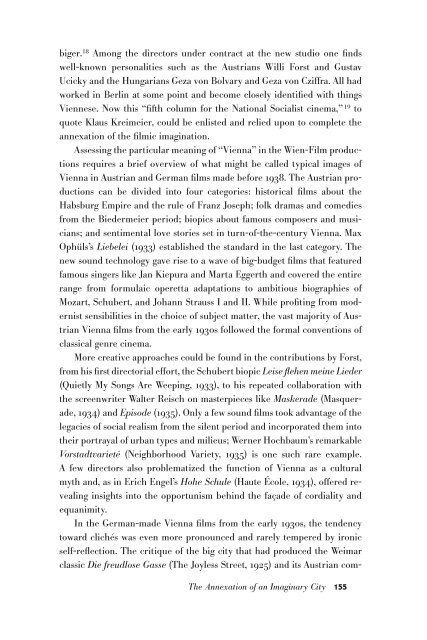You also want an ePaper? Increase the reach of your titles
YUMPU automatically turns print PDFs into web optimized ePapers that Google loves.
iger. 18 Among the directors under contract at the new studio one finds<br />
well-known personalities such as the Austrians Willi Forst and Gustav<br />
Ucicky and the Hungarians Geza von Bolvary and Geza von Cziffra. All had<br />
worked in Berlin at some point and become closely identified with things<br />
Viennese. Now this “fifth column for the National Socialist cinema,” 19 to<br />
quote Klaus Kreimeier, could be enlisted and relied upon to complete the<br />
annexation of the filmic imagination.<br />
Assessing the particular meaning of “Vienna” in the Wien-Film pr0ductions<br />
requires a brief overview of what might be called typical images of<br />
Vienna in Austrian and German films made before 1938. The Austrian productions<br />
can be divided into four categories: historical films about the<br />
Habsburg Empire and the rule of Franz Joseph; folk dramas and comedies<br />
from the Biedermeier period; biopics about famous composers and musicians;<br />
and sentimental love stories set in turn-of-the-century Vienna. Max<br />
Ophüls’s Liebelei (1933) established the standard in the last category. The<br />
new sound technology gave rise to a wave of big-budget films that featured<br />
famous singers like Jan Kiepura and Marta Eggerth and covered the entire<br />
range from formulaic operetta adaptations to ambitious biographies of<br />
Mozart, Schubert, and Johann Strauss I and II. While profiting from modernist<br />
sensibilities in the choice of subject matter, the vast majority of Austrian<br />
Vienna films from the early 1930s followed the formal conventions of<br />
classical genre cinema.<br />
More creative approaches could be found in the contributions by Forst,<br />
from his first directorial effort, the Schubert biopic Leise flehen meine Lieder<br />
(Quietly My Songs Are Weeping, 1933), to his repeated collaboration with<br />
the screenwriter Walter Reisch on masterpieces like Maskerade (Masquerade,<br />
1934) and Episode (1935). Only a few sound films took advantage of the<br />
legacies of social realism from the silent period and incorporated them into<br />
their portrayal of urban types and milieus; Werner Hochbaum’s remarkable<br />
Vorstadtvarieté (Neighborhood Variety, 1935) is one such rare example.<br />
A few directors also problematized the function of Vienna as a cultural<br />
myth and, as in Erich Engel’s Hohe Schule (Haute École, 1934), offered revealing<br />
insights into the opportunism behind the façade of cordiality and<br />
equanimity.<br />
In the German-made Vienna films from the early 1930s, the tendency<br />
toward clichés was even more pronounced and rarely tempered by ironic<br />
self-reflection. The critique of the big city that had produced the Weimar<br />
classic Die freudlose Gasse (The Joyless Street, 1925) and its Austrian com-<br />
The Annexation of an Imaginary City 155

















